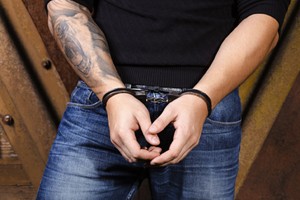 Kaboni Savage was a drug kingpin in Philadelphia. On his orders, his crew firebombed the home of a federal witness in 2004, killing six people, including four children. Savage was sentenced to death in May, 2013.
Kaboni Savage was a drug kingpin in Philadelphia. On his orders, his crew firebombed the home of a federal witness in 2004, killing six people, including four children. Savage was sentenced to death in May, 2013.
A few months later, the Philadelphia Inquirer wrote an article about the cost of prosecuting Kaboni Savage: Bill for Savage trial easily tops $10 million:
No one protested when a federal jury recommended in June that Kaboni Savage be put to death.
In just a few years, Savage had left a grisly trail in North Philadelphia. He gunned down one man, ordered the killing of five others, and directed the 2004 rowhouse firebombing that killed four children and two women.
The cocaine, PCP, and other drugs he peddled poisoned families, enticed boys into crime, and kept neighborhoods in decay.
According to the Inquirer, a police official once called Savage “pure evil.” He was convicted of 12 murders. The Inquirer wrote:
None was as tragic as the firebombing of the North Sixth Street house occupied by the family of Eugene Coleman, once a close friend and confidant of Savage’s who had agreed to testify against him.
Just before 5 a.m. Oct. 9, 2004, an enforcer enlisted by Savage doused the Coleman family house with gasoline, pumped gunshots up the stairs, and tossed in a lit gas can. The blaze killed Coleman’s 54-year-old mother, Marcella, and his 15-month old son, Damir Jenkins; a cousin, 34-year-old Tameka Nash; and Nash’s 10-year-old daughter, Khadjah, plus two other children, Tahj Porchea, 12, and Sean Rodriguez, 15.
Savage was in federal custody at the time, but in secret recordings played repeatedly for jurors, agents overheard him cackling and joking about the fire, and vowing to kill the mothers and children of all the “rats” who betrayed him.
“That’s all I dream about – killing rats,” he told his girlfriend in one call from prison.
I think it’s fair to assume that this man is a psychopath. But the story wasn’t about the criminal. It was about the shocking cost of prosecuting him more than $10 million. Some of the itemized expenses:
- Court-appointed lawyers for Savage and his co-defendants $3.3 million
- Per-diem payments and travel expenses for prospective jurors $325,000
- Juror lunches and snacks $24,000
- Transcripts $249,000
- Additional travel and security by the Marshals Service $283,000
- Cost of imprisoning Kaboni Savage $31,000 per year
So prosecuting one psychopath cost more than $10 million. At that rate, what do all psychopaths cost society?
The cost of crime
Kent A. Kiehl, associate professor of psychology and neuroscience at the University of New Mexico, and Morris B. Hoffman, district judge in the Second Judicial District, Denver, Colorado, came up with an estimate.
Kiehl and Hoffman authored a paper called The Criminal Psychopath: history, neuroscience, treatment and economics [51 Jurimetrics J. 355—397 (2011)] In it, they estimate that psychopaths are responsible for approximately $460 billion per year in criminal social costs.
How did they arrive at this figure?
They started with the work of David A. Anderson of the University of Chicago. Anderson wrote an article in 1999 called The Aggregate Burden of Crime. He estimated that crime costs society $1.7 trillion per year (in 1997 dollars).
Anderson’s estimate included police protection, corrections, prosecution, lost workdays, medical costs of gun violence, deterrence, crime prevention, implicit psychic and health costs, opportunity costs (time spent preventing, carrying out, and serving prison terms for criminal activity).
After presenting all his research, Anderson concluded:
As criminals acquire an estimated $603 billion worth of assets from their victims, they generate an additional $1,102 billion worth of lost productivity, crime-related expenses, and diminished quality of life. The net loses represent an annual per capita burden of $4,118. Including transfers, the aggregate burden of crime is $1,705 billion. In the United States, this is of the same order of magnitude as life insurance purchases ($1,680 billion), the outstanding mortgage debt to commercial banks and savings institutions ($1,853 billion), and annual expenditures on health ($1,038 billion). [Figures are 1997 dollars.]
Kiehl and Hoffman converted Anderson’s figure of $1.7 trillion in 1997 dollars to 2009 dollars. They say the social cost of crime at that time was $2.3 trillion.
Crime by psychopaths
Kiehl and Hoffman estimated how much of that crime was being committed by psychopaths. According to the authors, “Though psychopaths make up roughly 1% of the general male adult population, they make up between 15% and 25% of the males incarcerated in North American prison systems.”
They wrote:
If we assume 20% of the males in prison are psychopaths and that a similar percentage is involved in nonfelony offenses, and if we ignore the relatively small contributions of women offenders to this overall number, psychopaths alone are responsible for approximately $460 billion per year in criminal social costs.
By way of comparison, here are the estimated annual costs of other social problems:
- Alcohol and substance abuse $329 billion
- Obesity $200 billion
- Smoking $172 billion
- Schizophrenia $76 billion
Estimate is low
This cost of crime figure $460 billion is actually low, for three reasons.
First of all, Kiehl and Hoffman say it does not include the costs of psychopaths in psychiatric hospitals, and indirect costs such as the emotional suffering and treatment of victims.
Secondly, Kiehl and Hoffman are only including men who would be diagnosed as psychopaths, and they take great pains to differentiate psychopathy from antisocial personality disorder (ASPD). The diagnostic criteria for psychopathy are more stringent than the criteria for ASPD. Kiehl and Hoffman say 20% of male prisoners are psychopaths, but 85% of all prisoners suffer from antisocial personality disorder.
Finally, Kiehl and Hoffman did not include juveniles and women.
Most people who commit crime are probably disordered in some way. Still, even the figure of $2.3 trillion as the social cost of crime may be low. Does it include all the unethical and immoral acts of people with personality disorders like wiping out their spouse’s savings and running up their credit cards? I doubt it, because these actions, technically, are not illegal.
The point is, disordered individuals create huge costs, in real dollars, to society and everyone in it. Perhaps it’s time that we learned these dangerous social predators exist.
Lovefraud originally published this article on Sept. 23, 2013.





































 After the Narcissist, You Will Recover
After the Narcissist, You Will Recover
Sunnygal
For sure, it is time we learned these social predators exist.
monicapz
Although it kills me how much it costs to convict them, we need to be sure they are indeed guilty (they appear so normal that it is hard to tell them from the general population), especially in death penalty cases.
regretfullymine
the cost of psychopaths to society is immeasurable: lives shortened (illness/suicide), happy family lives ruined or grievously injured, legal/financial costs due to divorce/separations/violent deaths/domestic violence costs to law enforcement..money pits that these psychopaths become..it goes on and on.
Sunnygal
regretfully- So true.
Sunnygal
Most people only think there is abuse if there is physical abuse. They discount psychological abuse where most abuse is psychological. We need more education.
Sunnygal
These social predators exist.
Sunnygal
All the looting and vandalism that is going on now is costing alot.
Joanie Bentz, B.S., M.ED, LBS, CCBP
SG–it’s the “herd mentality”. We are accountable for our actions regardless of how we feel. Feelings are not facts. The enemy comes to steal, kill and destroy. The looters lack emotional empathy and possess a sense of entitlement–narcissism is rampant hiding under the guise of “a cause”.
Sunnygal
joanie- I agree.
SG
Sunnygal
Ghislaine Maxwell is charged with sex trafficking with Jeffrey Epstein. This is costing millions. She will claim she was just a victim. Is this true?
need2heal
Have you watched the documentary on Netflix? She was NOT a victim. There are plenty of women who were the teens that are willing to testify. She was involved in many of the sex acts. That’s no victim.
Redwald
Sunnygal, I’m sure what you said is not true. I think Ghislaine Maxwell is a viciously corrupt, wicked woman who belongs in jail for her horrendous abuses of young girls. If she claims to be a “victim,” she’s merely doing what many slippery, manipulative, opportunistic females like her do in similar circumstances. They latch onto a male partner to indulge their own appetites, whether it’s for personal or financial gain, for power, for the sheer thrill of committing crimes, or to gratify their own sexual sadism, as this Maxwell woman did. In other circumstances they just get the man to do their own dirty work for them. Then if they’re caught, they hide behind the man, saying they “did nothing” themselves, or if they did, that “he made me do it.” They let the man take the rap, while pretending to be “innocent” or even “victims” themselves, playing their accusers with the absurd myth of the supposed “innocence of women” that too many people fall for out of wishful thinking.
Depending on the type of crime involved, sometimes the woman is worse than her male accomplice! Larissa Schuster comes to mind, for instance. And as a classic example, I expect most people have heard of “Machine Gun Kelly,” back in the bad old gangster days of Prohibition. Kelly was given a fearsome reputation in the press and in legend, as if he were mowing people down wholesale with his Tommygun. Certainly he was a criminal, originally a bootlegger who later committed armed bank robberies, and I understand he was a good shot with a Thompson. That’s not easy; automatic weapons are tricky to control, if you’ve ever fired one.
Yet “George Kelly”–real name, George Kelly Barnes–never killed anyone, and compared with the really nasty guys around in those days–Capone, the Barker-Karpis gang, the Clyde Barrow gang, “Baby Face” Nelson and other ruthless killers–Kelly was a pussycat! It was his wife who put him up to his later most notorious deeds, and built his mythical reputation. Kathryn (which wasn’t her real name either) was an awful woman, but charmed George into marrying her in 1927 or 1928. He was about 34; she was only 23 or so, a criminal and bootlegger herself, with a criminal mother as well. Despite her youth, she had already dispensed with three previous husbands: two by divorce, the last one by murder, which she got away with by means of a fake suicide note. Husband George was reportedly not even keen on weapons, and it was Kathryn who bought him his Thompson and urged him to practice with it, spraying the countryside with .45 caliber slugs until he became a crack shot. Meanwhile she used her underworld contacts to build up her husband’s reputation as a “tough guy” with his new moniker of “Machine Gun” Kelly.
It was chiefly at Kathryn’s urging that George turned to bank robbery, and finally to their most famous crime, the kidnapping in 1933 of the oil millionaire Charles Urschel for $200,000 in ransom, worth millions today. Kathryn urged George to kill their victim once they got the ransom. If they released him, Urschel could lead the authorities back to his kidnappers. George refused to do it. Criminal though he was, he did have a conscience, and some shred of respect for human life. I’m sure Kathryn would have killed Urschel herself–she’d shot a previous husband through the head, after all–but she was damned if she’d be caught doing murder and taking the rap for it. So they let Urschel go once they got the money, and the detailed story of how, despite being blindfolded after his capture, he led the FBI back to the location of his kidnappers is fascinating in itself, though I don’t have the time to tell it right now.
George went to prison for the rest of his life, and on this occasion Kathryn didn’t get away with it either. She and her criminal mother, also involved in the plot, were sent to jail for 25 years, though Kathryn got out early enough to live for decades more, until she was over 80. But George was no problem in prison. He was always a model prisoner, never causing any trouble, and was never “taken seriously” by the other roughnecks in there because they knew he wasn’t a “tough guy” like them. He was a pretender at most. His wife was the mover and shaker behind his most notorious misdeeds and reputation.
Going back to Maxwell, I confess to feeling rather puzzled over the outrage at the suicide of her partner in crime, Jeffrey Epstein. Fair enough, there was a lapse in security at least. Sometimes people in custody kill themselves out of shock and depression when they deserved to be saved. That shouldn’t happen. And there are theories that he was murdered instead. That shouldn’t happen either. I know these are matters of principle. But in Epstein’s case, why does anyone really care? With a scumbag like Epstein, we’re better off with him dead. Who needs abusers like him walking the earth? And if he was a genuine suicide, in Japan I dare say they would see it simply as the “ultimate apology” for his crimes. The Japanese can be very sensible, practical people.
This is, after all, about the cost–in dollars alone, quite apart from the human damage they do–of predators like him. Who needs the cost of a trial, followed by the price of keeping this monster in jail for the rest of his life, probably running into seven figures, when his death dispenses with that burden on the taxpayer? My reaction to his death was “good riddance to bad rubbish!” I promise I wouldn’t cry for long if Ghislaine Maxwell did the same, and saved us another load of money.
Donna Andersen
Redwald – fascinating, as always. I didn’t know the Machine Gun Kelly story. And I agree – Epstein is gone. Good riddance.
Sunnygal
redwald- Some victims were disappointed he died because they wanted to confront him in court but they can sue his estate.
emilie18
I agree – the world is better off without the likes of Epstein, Maxwell and the scum they dealt with — as for confronting him in court — all we would have heard is more lies, excuses and whines. We will hear the truth from his victims – but never would have heard it from him or her.
Sunnygal
Trump said he wishes her well. I think like many people, Trump is unaware of the horrendous damage psychopaths do.
Redwald
The big-money-and-power crowd do hang together. Bill Clinton was a good friend of Epstein’s as well. I ran across this Daily Mail article with an amusing painting of Clinton in a blue dress hanging in Epstein’s townhouse.
Sunnygal
Yes, they do but I think they were all conned y him. He was a ultimate con artist.